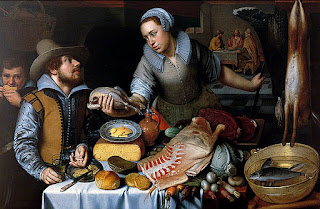I've just finished reading the El reino de este mundo, 'The Kingdom of this World' (1949) by Alejo Carpentier.
Alejo Carpentier (1904-1980) was a Cuban writer and musicologist who lived in Europe from 1928-38. He returned to Cuba in 1939 to marry but disliking its political atmosphere chose to live in Venezuela instead. When the Cuban revolution occurred in 1959 he returned to become Vice-President of the National Council of Culture, Professor of the History of Culture and eventually Director of the Cuban State publishing House.
Carpentier's novella (112 pp.) is set in Haiti at the end of the eighteenth century. It describes the events in which African slaves fought French colonists for their freedom and human rights to establish a short-lived Black Republic. It's written from the perspective of the protagonist Ti Noel, a black slave who witnesses the events in Haiti first-hand.
Although Haiti achieved independence in 1804, the protagonist Ti Noel realizes that the newly-formed Republic is in some ways even worse than colonial rule, 'for the colonists... had at least been careful not to kill their slaves, for dead slaves were money out of their pockets'. Whereas in the new Black Republic the death of a slave is seen as an easily replaceable commodity, the high-birth rate ensuring a constant supply of new slaves. Thus as it ever was, the cry to defeat tyranny with freedom is replaced by the new ruling elite's justification of a new form of tyranny.
Alejo Carpentier's left-wing viewpoint on the human condition argues that-
....a man never knows for whom he suffers and hopes. He suffers and hopes and toils for people he will never know, and for who, in turn, will suffer and hope and toil for others who will not be happy either, for man always seeks a happiness far beyond that which is meted out to him. But man's greatness consists in the very fact of wanting to be better than what he is. In laying duties upon himself. In the Kingdom of Heaven there is no grandeur to be won, inasmuch as there all is an established hierarchy, the unknown is revealed, existence is infinite, there is no possibility of sacrifice, all is rest and joy. For this reason, bowed down by suffering and duties, beautiful in the midst of his misery, capable of loving in the face of afflictions and trials, man finds his greatness, his fullest measure, only in the Kingdom of This World.
Carpentier is credited with coining the term lo real maravilloso (roughly the "marvelous reality") in the prologue to 'The Kingdom of this World' and the novella is often cited as one of the very earliest examples of the genre of 'magic realism', in which reality and elements of fantasy are mixed to produce a cocktail of highly imaginative literature. Carpentier's familiarity with the Surrealist movement while living in Paris, his admiration of the Spanish author Miguel de Cervantes, his left-wing politics, interest in Voodoo and ethnicity, all amalgamate in 'The Kingdom of this World' to produce what is seen by many as one of the earliest examples of 'magical realism' writing.
The Argentinian author Jorge Luis Borges is credited as one of the key innovators of 'magic realism' writing in which aspects of reality are blurred with magical elements. The Colombian author Gabriel Garcia Marquez's novel 'One hundred years of solitude' (1967) is also often cited as a seminal example of this genre. However, although 'magic realism' is frequently associated with the literature of South America, the human imagination transcends national boundaries.
Other novelists who have utilized elements of 'magic realism' in their writing include (and this inventory is far from inclusive) the Australian novelist Peter Carey's 'Illywhacker' (1985), Salman Rushdie's 'The Satanic Verses' (1988), Patrick Suskind's 'Perfume' (1985), Gunther Grass' 'The Tin Drum'(1959) and not least, the supreme worlk of Russian magical realism, if not the 20th century, Mikhail Bulgakov's 'The Master Margarita' (1940).
But in fact the employment of 'magical' or 'fantastic' elements in modern Literature, in particular English Literature can be traced as far back as Jonathan Swift's' 'Gulliver's Travels' (1735). 'Fantastic' or fantasy elements pervade English literary works, especially literature loved by children and adults alike, including Lewis Carroll's 'Alice in Wonderland' (1865), and Kenneth Grahame's 'The Wind in the Willows' (1908) .
Personally, dare I propose it, one of the greatest of all 'magical realism' writings is by an author whom Jorge Borges was a great admirer of, Sir Thomas Browne's 'The Garden of Cyrus' (1658). As T. S. Eliot long ago realized, 'Mankind cannot bear very much reality'.




































